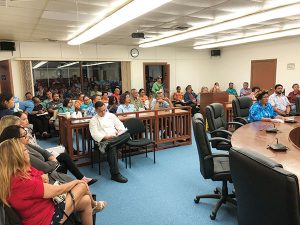DPL: Straight 55-year lease ‘better’

The House chamber on Capital Hill was packed as a public hearing on legislation extending the maximum lease length for public lands was held last Monday. (Erwin Encinares)
The Department of Public Lands suggests that the lease extension bill would be better off with lease agreements of 55 years straight, instead of an initial 40 years and the option to extend an additional 15 years.
In comments submitted Monday evening at the House Natural Resources Committee public hearing on Senate President Arnold I. Palacios’ (R-Saipan) Senate Bill 20-35, DPL suggested that the Legislature amend the initial lease from 25 years to 55 years instead, but without the option to extend.
Rep. Alice Igitol (R-Saipan) chairs the committee.
“Should you be inclined to increase lease terms to 55 years, we recommend making it straight 55 years (on par with private land leases) instead of 40 [years] plus an extension of 15 [years],” said DPL Secretary Marianne Teregeyo in her written comments on the bill.
S.B. 20-35 seeks to extend the maximum initial lease term from 25 years to 40 years, allowing for a maximum of 55 years, including the 15 years extension if granted.
“This way, investors can plan for a 55-year horizon, which more fully addresses the concern of investors stated in the bill,” Teregeyo said, referring to investors’ feedback on the thought of “having to fight for an extension” as a deterrence to further invest, after having already developed the property.
Teregeyo cited “little added benefit” for DPL and those of Northern Marianas descent if the initial term of 25 years is changed to 40 years, and that, at the end of 55 years, the CNMI will be faced with the same situation of “investors wanting longer leases again to ‘recoup’ their investments.”
She pointed out that public land lease terms of 25 years, with an opportunity to extend for an additional 15 years with the approval of the CNMI Legislature, was designed to give investors time for their investment to generate sufficient returns as well as a mechanism to allow the CNMI to re-evaluate the situation for a new leasing decision after the initial 25-year term. She said this has been so since the enactment of the CNMI Constitution back in 1978.
“The benefit of re-evaluating at 25 years is significant because, at that point, there still remains sufficient useful life in the facility for the lessee to want a 15-year extension, which provides us some leverage to condition the approval of the extension on a certain level of improvements being made on the property as well as performance standards on the lease,” Teregeyo explained, adding that the benefit of re-evaluating after the initial term might be lost if investors lose interest in gaining a 15-year extension on a 40-year-old facility with “little remaining useful life.”



























